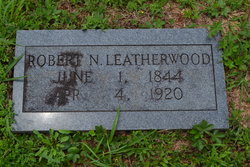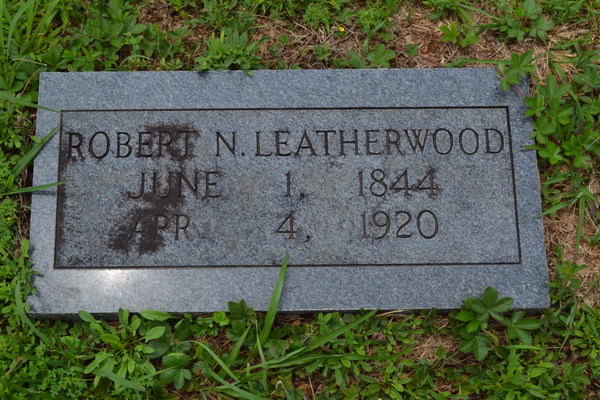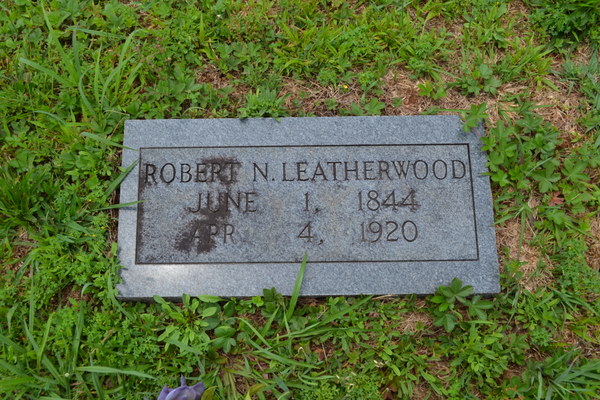Arizona Pioneer
Prominent citizen of Tucson, AZ
When he arrived in the "Old Pueblo" of Tucson, AZ in May 1869, he numbered among his most treasured possessions his Confederate army uniform, a garb that he wore at all important functions, even to his last—his funeral. By 1870, He bought land where the Pima County Courthouse now stands and built and outfitted a stable. He transferred from Clay Masonic Lodge #301 in NC and became a charter member of the first Tucson masonic Lodge #263- (now #4) where the record book lists his name with signature as Rufus Nelson Leatherwood. He was elected to the Village Council of Tucson in 1874 and began a period of 25-years in public office. He served on the council five consecutive terms, was elected Treasurer in November 1878 and became Mayor of Tucson in 1880, the year the railroad reached the town.
In a moment of deep civic pride, Leatherwood determined that the outer world should be informed of the great event and sent telegrams to a number of dignitaries including US President Hayes. He was persuaded to also send a telegram to the Pope which read: "To His Holiness, the Pope of Rome, Italy. The Mayor of Tucson begs the honor of reminding your Holiness that this ancient and honorable pueblo was founded by the Spaniards more than three centuries ago and to inform your Holiness that a railroad from San Francisco, California now connects us to the Christian world."
{signed} R. N. Leatherwood
A small group of Leatherwood's friends drafted what was purported to be a reply to be read at the celebratory banquet. "His Holiness the Pope acknowledges with appreciation receipt of your telegram informing him that the ancient city of Tucson at last has been connected with the outside world and sends his benediction, but for his own satisfaction would ask, Where the hell is Tucson?"
{signed} Antonell
Leatherwood assumed that Antonell was the Pope's secretary and for days after the event neither he nor others would believe that the telegram hadn't actually originated at Rome.
As mayor, Leatherwood established the first speed limit at five miles per hour on horseback or in a carriage and a city jail was requested to be housed in the old three-room arsenal. The mayor requested a full-time attorney on a yearly basis and he resigned from politics in 1881-1882 to sell his land and Leatherwood Stable to Pima County so that a courthouse could be built. He was elected to the 13th territorial legislature in 1885, returned to the 14th and the 17th-(1893-'94). During 1886, he helped organize the Tucson Rangers, a group of 50 men involved in law enforcement. The next few years, he helped promote the gravity water system for Tucson. He was elected as sheriff in 1894 for a two-year term and re-elected in 1896. He was known to every cattle rustler and outlaw between El Paso and California, as a man to be feared and avoided. One incident was his untiring tracking of two murderers for months, finally locating them in Death Valley and returning them in irons to the Tucson jail. In 1904, he was the Commissioner for the AZ Territory in charge of the Arizona exhibit at the World's Fair at St. Louis. He was an unsuccessful primary candidate for the state senate in 1914, his last attempt at public office. Contemporaries stated he was only 5 feet 5 inches tall and weighed 130 pounds but this peppery man had the political instincts of the Southerner and did his own campaigning from horseback.
The last years of his life were spent on the north slopes of the Catalina Mountains at Apache Camp, living in a pine board cabin on Rattlesnake Gulch. He had owned the mining interests in the area but had sold them to the Copper Queen Mining Co. staying on as a caretaker for the company. He lived in a tent house the last ten years or so of his life in his famous peach and apple orchard.
He died the evening of April 3, 1920 at Rossi's Restaurant on East Congress and burial services were held in the Red Room of the Masonic Temple on the 6th.
Buried in Murphy, Cherokee County, NC.
R.I.P.
SOURCE: ARIZONIANA, AZ Pioneers Historical Society, Tucson, AZ,
Vol. 1, Winter 1960, Num. 4, p. 14
----Quoted from:
"Robert N. Leatherwood", by Mable Forseth Blow
(Site under construction-- the transfer of this memorial is much appreciated.)
Silas Griffin, Griffin's Research and Veteran's Eclat- (G.R.a.V.E.), 1999-2013
In Observance of the Arizona Centennial, 1912-2012
Arizona Pioneer
Prominent citizen of Tucson, AZ
When he arrived in the "Old Pueblo" of Tucson, AZ in May 1869, he numbered among his most treasured possessions his Confederate army uniform, a garb that he wore at all important functions, even to his last—his funeral. By 1870, He bought land where the Pima County Courthouse now stands and built and outfitted a stable. He transferred from Clay Masonic Lodge #301 in NC and became a charter member of the first Tucson masonic Lodge #263- (now #4) where the record book lists his name with signature as Rufus Nelson Leatherwood. He was elected to the Village Council of Tucson in 1874 and began a period of 25-years in public office. He served on the council five consecutive terms, was elected Treasurer in November 1878 and became Mayor of Tucson in 1880, the year the railroad reached the town.
In a moment of deep civic pride, Leatherwood determined that the outer world should be informed of the great event and sent telegrams to a number of dignitaries including US President Hayes. He was persuaded to also send a telegram to the Pope which read: "To His Holiness, the Pope of Rome, Italy. The Mayor of Tucson begs the honor of reminding your Holiness that this ancient and honorable pueblo was founded by the Spaniards more than three centuries ago and to inform your Holiness that a railroad from San Francisco, California now connects us to the Christian world."
{signed} R. N. Leatherwood
A small group of Leatherwood's friends drafted what was purported to be a reply to be read at the celebratory banquet. "His Holiness the Pope acknowledges with appreciation receipt of your telegram informing him that the ancient city of Tucson at last has been connected with the outside world and sends his benediction, but for his own satisfaction would ask, Where the hell is Tucson?"
{signed} Antonell
Leatherwood assumed that Antonell was the Pope's secretary and for days after the event neither he nor others would believe that the telegram hadn't actually originated at Rome.
As mayor, Leatherwood established the first speed limit at five miles per hour on horseback or in a carriage and a city jail was requested to be housed in the old three-room arsenal. The mayor requested a full-time attorney on a yearly basis and he resigned from politics in 1881-1882 to sell his land and Leatherwood Stable to Pima County so that a courthouse could be built. He was elected to the 13th territorial legislature in 1885, returned to the 14th and the 17th-(1893-'94). During 1886, he helped organize the Tucson Rangers, a group of 50 men involved in law enforcement. The next few years, he helped promote the gravity water system for Tucson. He was elected as sheriff in 1894 for a two-year term and re-elected in 1896. He was known to every cattle rustler and outlaw between El Paso and California, as a man to be feared and avoided. One incident was his untiring tracking of two murderers for months, finally locating them in Death Valley and returning them in irons to the Tucson jail. In 1904, he was the Commissioner for the AZ Territory in charge of the Arizona exhibit at the World's Fair at St. Louis. He was an unsuccessful primary candidate for the state senate in 1914, his last attempt at public office. Contemporaries stated he was only 5 feet 5 inches tall and weighed 130 pounds but this peppery man had the political instincts of the Southerner and did his own campaigning from horseback.
The last years of his life were spent on the north slopes of the Catalina Mountains at Apache Camp, living in a pine board cabin on Rattlesnake Gulch. He had owned the mining interests in the area but had sold them to the Copper Queen Mining Co. staying on as a caretaker for the company. He lived in a tent house the last ten years or so of his life in his famous peach and apple orchard.
He died the evening of April 3, 1920 at Rossi's Restaurant on East Congress and burial services were held in the Red Room of the Masonic Temple on the 6th.
Buried in Murphy, Cherokee County, NC.
R.I.P.
SOURCE: ARIZONIANA, AZ Pioneers Historical Society, Tucson, AZ,
Vol. 1, Winter 1960, Num. 4, p. 14
----Quoted from:
"Robert N. Leatherwood", by Mable Forseth Blow
(Site under construction-- the transfer of this memorial is much appreciated.)
Silas Griffin, Griffin's Research and Veteran's Eclat- (G.R.a.V.E.), 1999-2013
In Observance of the Arizona Centennial, 1912-2012
Sponsored by Ancestry
Advertisement
Explore more
Sponsored by Ancestry
Advertisement



